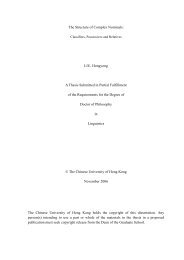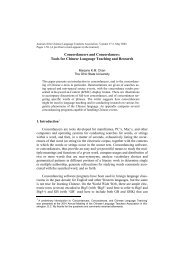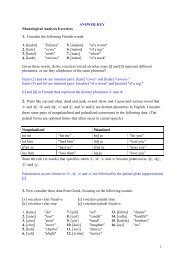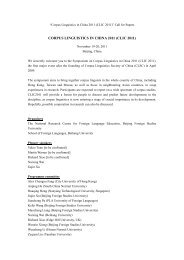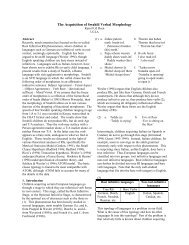The mnemonic keyword method: The effects of bidirectional retrieval ...
The mnemonic keyword method: The effects of bidirectional retrieval ...
The mnemonic keyword method: The effects of bidirectional retrieval ...
You also want an ePaper? Increase the reach of your titles
YUMPU automatically turns print PDFs into web optimized ePapers that Google loves.
M. Wyra et al. / Learning and Instruction 17 (2007) 360e371<br />
361<br />
For those whose first language is English, the standard <strong>keyword</strong> <strong>method</strong> for acquiring new foreign-language vocabulary<br />
involves a two-stage process: generation <strong>of</strong> an English word, the <strong>keyword</strong>, that is similar in sound or appearance<br />
to the new FL word; and development <strong>of</strong> an interactive image involving that <strong>keyword</strong> and the definition <strong>of</strong> the<br />
new word. For example, to learn that apio (Spanish) means celery (English), a learner could choose the English word<br />
‘‘ape’’ as a <strong>keyword</strong>. <strong>The</strong>n the learner might create an interactive image <strong>of</strong> an ape carrying a huge bunch <strong>of</strong> celery. For<br />
<strong>retrieval</strong> <strong>of</strong> the definition when given the FL word, it is commonly suggested that the processes involved in the encoding<br />
procedure be adapted along the following lines: the FL word is examined for presence <strong>of</strong> a <strong>keyword</strong>; a search is<br />
made for images involving the <strong>keyword</strong>; and any image generated is scanned to identify the most prominent feature<br />
(Carney & Levin, 1998; Ellis & Beaton, 1993). Such <strong>retrieval</strong> is <strong>of</strong>ten referred to as receptive or forward recall. If the<br />
direction <strong>of</strong> recall was to be from the definition to the FL word (productive or backward recall), the <strong>retrieval</strong> procedure<br />
would need to be further adapted to access an image <strong>of</strong> the definition and then to identify a component <strong>of</strong> the image<br />
that would suggest a <strong>keyword</strong> that might then be used to cue <strong>retrieval</strong> <strong>of</strong> the FL word.<br />
1.1. <strong>The</strong> <strong>keyword</strong> <strong>method</strong> at time <strong>of</strong> <strong>retrieval</strong><br />
It is difficult to find evidence in reports <strong>of</strong> previous <strong>keyword</strong> <strong>method</strong> studies indicating that explicit <strong>retrieval</strong> training<br />
has been given to learners. In most reports on the <strong>keyword</strong> <strong>method</strong> it is the steps involved in encoding that are given<br />
most attention.<br />
Recently, Crutcher and Ericsson (2000, 2003) identified two models <strong>of</strong> <strong>retrieval</strong> that could be operative during<br />
recall <strong>of</strong> the definition <strong>of</strong> FL words that had been learned using the <strong>keyword</strong> <strong>method</strong>. In the direct access model <strong>of</strong><br />
<strong>retrieval</strong> it is proposed that <strong>retrieval</strong> occurs through accessing <strong>of</strong> a simple associative link between the FL word<br />
and the definition, without the involvement <strong>of</strong> the mediational <strong>keyword</strong>. In contrast, in the mediational model <strong>retrieval</strong><br />
results from accessing <strong>of</strong> the <strong>keyword</strong> mediator that links the FL word and its definition. Using SpanisheEnglish vocabulary<br />
items Crutcher and Ericsson (2000) found that the evidence available from accuracy, latency and verbal report<br />
data supported the mediational model <strong>of</strong> <strong>retrieval</strong> when moderate amounts <strong>of</strong> practice used in most <strong>keyword</strong><br />
research is provided. When the amount <strong>of</strong> practice given to the vocabulary pairs was substantially increased, the pattern<br />
<strong>of</strong> recall performance was more compatible with ‘‘a process in which the English equivalent is directly accessed<br />
from the Spanish word with no intermediate working memory steps’’ (p. 1312).<br />
<strong>The</strong> results <strong>of</strong> the Crutcher and Ericsson research provide support for the description <strong>of</strong> <strong>retrieval</strong> processes involving<br />
<strong>keyword</strong>s and images suggested by Carney and Levin (1998) and Ellis and Beaton (1993). Under typical <strong>keyword</strong><br />
training conditions, which do not involve large numbers <strong>of</strong> practice trials, the <strong>keyword</strong> mediators can be predicted to<br />
act as cues for <strong>retrieval</strong> <strong>of</strong> the definitions. <strong>The</strong> strength <strong>of</strong> this evidence suggested that it would be <strong>of</strong> interest to see if<br />
the impact <strong>of</strong> the <strong>keyword</strong> <strong>method</strong> training could be enhanced by providing more attention to the use <strong>of</strong> the <strong>keyword</strong><br />
procedure at time <strong>of</strong> <strong>retrieval</strong>. To this end we set out to compare the <strong>effects</strong> <strong>of</strong> a standard <strong>keyword</strong> training condition<br />
with one in which students were given additional training in use <strong>of</strong> the <strong>keyword</strong> procedure at time <strong>of</strong> <strong>retrieval</strong>. On the<br />
basis <strong>of</strong> the evidence available from Crutcher and Ericsson (2000) we predicted that further <strong>retrieval</strong> training would<br />
increase the level <strong>of</strong> recall beyond that associated with the typical <strong>keyword</strong> <strong>method</strong> training in which the major<br />
emphasis was on the encoding procedure. Compared with the typical encoding training we expected that practice<br />
in adaptation <strong>of</strong> the <strong>keyword</strong> elements for <strong>retrieval</strong> would increase the influence <strong>of</strong> <strong>keyword</strong> mediators and that<br />
this would impact positively on recall performance.<br />
1.2. Ability to make images<br />
A second issue <strong>of</strong> concern in this paper was the influence <strong>of</strong> individual differences in students’ ability to make<br />
images in the <strong>keyword</strong> <strong>method</strong>. Imaging is a process in which individual differences are predicted to be influential.<br />
Kosslyn, Van Kleeck, and Kirby’s (1990) theory <strong>of</strong> processing subsystems represents visual imagery as involving<br />
high-level processes that use ‘‘stored information to reconstruct the appearance <strong>of</strong>, reinterpret, and possibly anticipate<br />
the consequences <strong>of</strong> transforming an object.’’ (p. 42). In this theory four imagery abilities are proposed: those involved<br />
in generation, transformation, inspection and maintenance <strong>of</strong> the image. Individual differences are predicted in each <strong>of</strong><br />
these abilities, arising from individual differences in the underlying processing subsystems. Kosslyn et al. (1990)<br />
argued that their experimental results provide strong support for the predictions generated from this model. Individual



